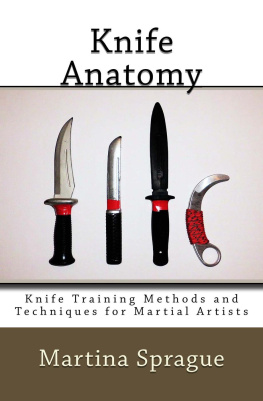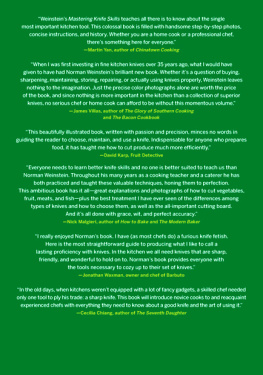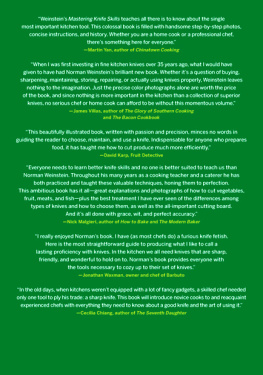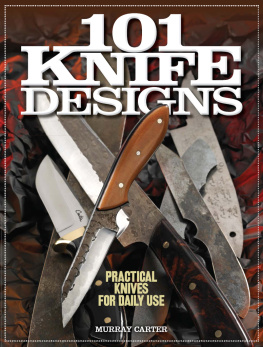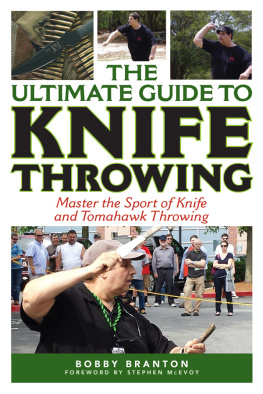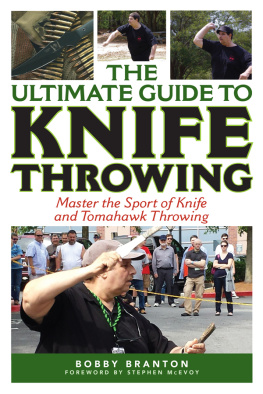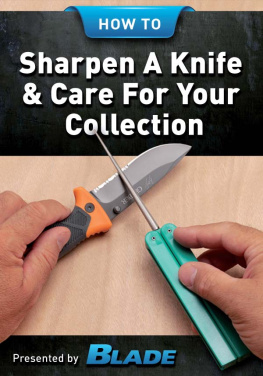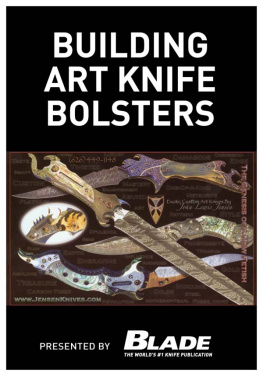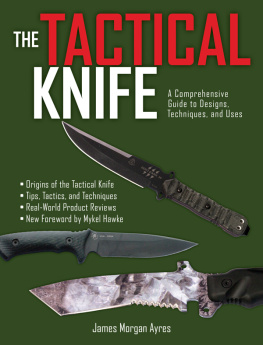Knife Anatomy
Book 1
Knife Training Methods and Techniques for Martial Artists
by Martina Sprague
Copyright 2012 Martina Sprague
No part of this book may be reproduced in any form or by any means, electronic or otherwise, without the prior written consent of the author.
Disclaimer: Always use caution and never use real knives when practicing the martial arts exercises in this book. The reader assumes full responsibility for injuries incurred by doing the exercises described herein, and for the use or misuse of any information contained in this book. The author does not endorse the use of edged weapons as a means for resolving conflict. The instruction in this book is purely informational in purpose and intended to strengthen the martial artists empty-hand skills.
TABLE OF CONTENTS
T he purpose of the Knife Training Methods and Techniques for Martial Artists series is to emphasize how tradition and culture have affected our views of the martial arts and bring increased understanding of the knife as a weapon of offense and defense, while simultaneously strengthening the empty-hand skills of the martial artist.
Traditional martial arts take a philosophical as well as a combat approach to resolving issues of violence. As a result we study self- defense . Offense is looked upon as a last resort when all else fails, and the value of training in knife offense can prove controversial. However, two concepts should not be confused: First, no respectable strategist says no thanks to knowledge. Learning all you can about yourself, your opponent, and your weapons (whether knives or empty hands), makes you a wiser martial artist, combatant, or defender of self and others. Second, education, clear-sightedness, and ownership of your abilities with edged weapons does in no way imply that you are aggressive, macho, cruel, careless, or out looking for a fight. Learning about knife offense does not detract from the traditional martial art mindset of defending against assault by walking away or doing the least amount of harm possible.
The typical idea of a knife fight is of two people pitted against each other in an enclosed area, street corner, alley, bar, or in the jungles of warfare, knife against knife, attempting stabs and cuts at each other until one person emerges victorious. This type of scenario is a rare occurrence. There is really no such thing as knife fighting per se. There are defenses against knife attacks and muggings; there are uses of the knife to dispose of an opponent quickly or as an equalizer in an assault; and there are times when the knife is deployed as a threat; for example, in a hostage situation or to coerce the victim into giving something up. The person armed with a knife has a definite objective in mind: He or she wants your life or your body, or some other thing of value. But he is not interested in sparring with the knife. No two people in their right minds would go knife against knife, because the odds are that only one can survive the fight, and that the survivor will at best be severely injured.
According to the National Crime Victimization Survey, 1993-2001, conducted by the U.S. Department of Justice, While victimizations involving knives comprised 6% of all violent crimes resulting in an injury, these victimizations accounted for about 24% of all serious injuries experienced by crime victims. By contrast, victimizations involving firearms comprised 10% of all violent crimes resulting in an injury, but only accounted for 13% of all serious injuries experienced by crime victims. In other words, approximately twice as many people were seriously injured in an assault involving a knife than in an assault involving a firearm, despite the fact that only about half as many assaults involved a knife. Since edged weapons attacks often comprise multiple stabs or slashes, the victim is also more likely to die from the attack than from a gunshot wound, and in many cases never sees the knife and therefore has little opportunity defending against it. This should give you some idea as to the dangers of the knife. This series of books is therefore more about knife education than about knife fighting. With that said, lets look at the knife from the traditional martial arts viewpoint.
An ancient warrior principle states: No method, whatever its merit, has any value unless it helps develop a mans character in a manner which would make him master of himself. Great power lies in knowing that you can, but wont. The martial arts are an expression of combat; they teach us how a dangerous situation might unfold and the options we have available. Chances are the average citizen can avoid getting into a situation involving a knife just by being observant and careful with the places he or she frequents, and by recognizing the breeding grounds for domestic violence before reaching the point of no return. However, the possibility still exists that sometime in your life you will need to come to another persons assistance, or find yourself face-to-face with a knife-wielding assailant. The key to confidence in self-defense is education along with the knowledge that you have what it takes. The intent of this series of books is to give the martial arts interested person a solid background on the importance of the knife as a combat weapon, to inspire the reader about the benefits of knife training, and to provide detailed step-by-step instruction in how to manipulate and defend against a knife with speed, proficiency, and confidence. Studying the knife is also valuable to the person who seeks an education for no other reason than a personal interest in combat history.
The series of books has three objectives: The first few books focus on getting to know the knife, its strengths and weaknesses, and on manipulating and using it. The next few books focus on defending against knife attacks. The last few books focus on implementing empty-hand martial arts skills into your knife training, and include scenario-based exercises intended to bring your knowledge into perspective and give you a solid understanding of your strengths and weaknesses when faced with a knife-wielding assailant. Each book starts with an introduction. You are then given the lesson objectives, along with detailed information and a number of training exercises aimed at making you physically and emotionally ready to participate in traditional martial arts demonstrations involving a knife or, if fate will have it, in a real encounter.
As you go through the training exercises, remember that almost any martial art, traditional or modern, can be adapted to knife offense and defense without changing the basic principles of the art. Since the knife is a relatively small and lightweight weapon, many of the same moves and movement patterns you use in your empty-hand art are easily transferable to your knife techniques, and vice versa. Knife training enhances your traditional skills by teaching you spontaneity and precision. Since the knife requires so little force to operate, it is also a useful alternative in a self-defense situation that has you physically and mentally weakened, for example, through an injury or as a result of physical exhaustion. The practical lessons you learn by adding knife training to your arsenal include quick reaction skills, physical and mental control, footwork and evasion tactics, distance control, and target precision.
Next page
